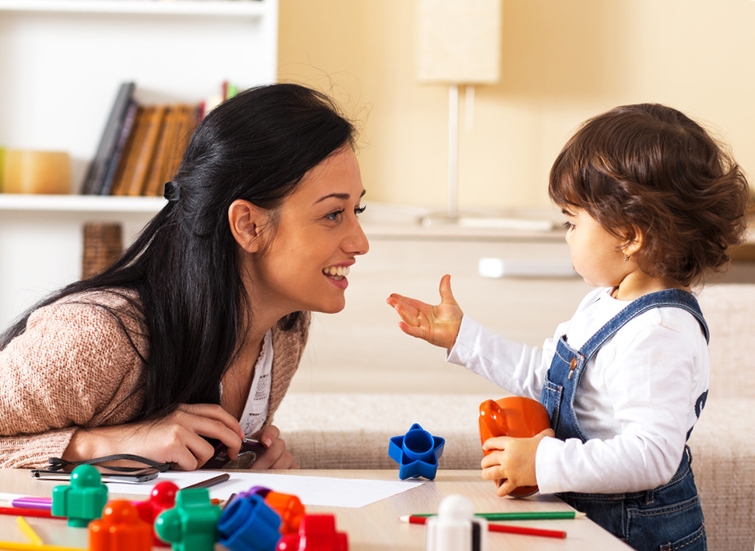Although the first year is really important for language development in children, major learning continues throughout a child’s early years. And learning language is a lifelong process.
Language and communication skills are critical to a child’s development. Good communication makes them better able to engage in socialization and to learn from their environment and from formal classroom instruction. When we talk about communication we are talking about both speech which is the verbal means of communication and language which is using shared rules to put words together to express thoughts and feelings as well has to understand the meaning of language through both spoken and written communication. Since parents are a child’s first teacher, knowledge of language development in children improves their ability to interact with their child to stimulate and guide them in their ability to understand and communicate with their environment.
Contents
Speech Vs Language
Speech
Speech means producing the sounds that form words. It’s a physical activity that is controlled by the brain. Speech requires coordinated, precise movement from the tongue, lips, jaw, palate, lungs and voice box.
Making these precise movements takes a lot of practice, and that’s what children do in the first 12 months. Children learn to correctly make speech sounds as they develop, with some sounds taking more time than others.
Language
Language is the words that your child understands and uses as well as how he uses them. Language includes spoken and written language. The parts that make up language include vocabulary, grammar and discourse:
- Vocabulary is the store of words a person has – like a dictionary held in long-term memory.
- Grammar, or syntax, is a set of rules about the order in which words should be used in sentences. These rules are learned through the experience of language.
- Discourse is a language skill that we use to structure sentences into conversations, tell stories, poems and jokes, and for writing recipes or letters.
Four Main Components of Language
- Phonology involves the rules about the structure and sequence of speech sounds.
- Semantics consists of vocabulary and how concepts are expressed through words.
- Grammar involves two parts. The first, syntax, is the rules in which words are arranged into sentences. The second, morphology, is the use of grammatical markers (indicating tense, active or passive voice etc.).
- Pragmatics involves the rules for appropriate and effective communication. Pragmatics involves three skills:
- using language for greeting, demanding etc.
- changing language for talking differently depending on who it is you are talking to
- following rules such as turn taking, staying on topic
From birth on, children are programmed to develop speech and language. The first five years are most critical but language development continues throughout early childhood and on into adolescence. During the first five years stimulation of language development is important as the brain is both developing new nerve cells as well as multiple connections between nerve cells to serve the function of language both expressive and receptive. Lack of stimulation during this time could result in a child making slower progress or end up with poor communication skills. Later, we provide some tips for parents on how to help with language development but the basic suggestions are to spend lots of time talking, singing and reading to your child.
In the early stages of language development, the brain is programmed to attend to speech sounds and begin to mimic them. Early on babies like to make sounds up on their own. Later they attempt to repeat sounds/words that they are exposed to from their environment.
Language Development Time Lines
Infant (Birth to 18 months)
Birth to 6 Months
- Vocalization with intonation
- Responds to his name
- Responds to human voices without visual cues by turning his head and eyes
- Responds appropriately to friendly and angry tones
Six to 12 Months
- Uses one or more words with meaning (this may be a fragment of a word)
- Understands simple instructions, especially if vocal or physical cues are given
- Practices inflection
- Is aware of the social value of speech
12 to 18 Months
- Has vocabulary of approximately 5-20 words
- Vocabulary made up chiefly of nouns
- Some echolalia (repeating a word or phrase over and over)
- Much jargon with emotional content
- Is able to follow simple commands
Toddler (18 m – 3y)
18 To 24 Months
- Can name a number of objects common to his surroundings
- Is able to use at least two prepositions, usually chosen from the following: in, on, under
- Combines words into a short sentence-largely noun-verb combinations (mean) length of sentences is given as 1.2 words
- Approximately 2/3 of what child says should be intelligible
- Vocabulary of approximately 150-300 words
- Rhythm and fluency often poor
- Volume and pitch of voice not yet well-controlled
- Can use two pronouns correctly: I, me, you, although me and I are often confused
- My and mine are beginning to emerge
- Responds to such commands as “show me your eyes (nose, mouth, hair)”
Two to Three Years
- Use pronouns I, you, me correctly
- Is using some plurals and past tenses
- Knows at least three prepositions, usually in, on, under
- Knows chief parts of body and should be able to indicate these if not name
- Handles three word sentences easily
- Has in the neighborhood of 900-1000 words
- About 90% of what child says should be intelligible
- Verbs begin to predominate
- Understands most simple questions dealing with his environment and activities
- Relates his experiences so that they can be followed with reason
- Able to reason out such questions as “what must you do when you are sleepy, hungry, cool, or thirsty?”
- Should be able to give his sex, name, age
- Should not be expected to answer all questions even though he understands what is expected
Preschooler (3y – 5y)
Three to Four Years
- Knows names of familiar animals
- Can use at least four prepositions or can demonstrate his understanding of their meaning when given commands
- Names common objects in picture books or magazines
- Knows one or more colors
- Can repeat 4 digits when they are given slowly
- Can usually repeat words of four syllables
- Demonstrates understanding of over and under
- Has most vowels and diphthongs and the consonants p, b, m, w, n well established
- Often indulges in make-believe
- Extensive verbalization as he carries out activities
- Understands such concepts as longer, larger, when a contrast is presented
- Readily follows simple commands even thought the stimulus objects are not in sight
- Much repetition of words, phrases, syllables, and even sounds
Four to Five Years
- Uses possessives
- Uses double negatives
- Joins sentences
- Can answer how, who, when questions
- Follows up to 4 step directions
- Uses third person
- Tells simple jokes
- Says full name.
- Knows an average of 900 words.
- Shows rapid language development.
- Uses sentences that are three to four words long.
- Mispronounces 40 percent of speech sounds.
- Enjoys listening to stories.
- Understands more words than able to use.
- Asks simple who and what questions.
- Tells simple events in sequence.
- Demonstrates beginning phonological awareness (hearing and recognizing the sounds of language).
- Uses words to express ideas and feelings.
- Usually follows requests and can be reasoned with.
Five to Six Years
- In addition to the above consonants these should be mastered: f, v, sh, zh, th,1
- He should have concepts of 7
- Speech should be completely intelligible and socially useful
- Should be able to tell one a rather connected story about a picture, seeing relationships between objects and happenings
School Age (6y – 8y)
Six to Seven Years
- Should have mastered the consonants s-z, r, voiceless th, ch, wh, and the soft g as in George
- Should handle opposite analogies easily: girl-boy, man-woman, flies-swims, blunt-sharp short-long, sweet-sour, etc
- Understands such terms as: alike, different, beginning, end, etc
- Should be able to tell time to quarter hour
- Should be able to do simple reading and to write or print many words
Seven to Eight Years
- Begins to use reference books.
- Enjoys reading aloud.
- Enjoys mysteries, adventure stories and biographies.
- Adjusts language and vocabulary to fit an audience, topic, or purpose.
- Develops vocabulary from textbooks and personal reading.
- Gives precise directions and instructions for more complex activities and tasks.
- Tells and retells stories in a formal storytelling format using descriptive language, story elements, and voice to create interest and mood.
- Demonstrates effective listening skills by exhibiting appropriate body language.
- Uses a variety of simple and compoundsentences of varied lengths.
How to Stimulate Language Development
Early Years
- Verbally respond to your baby’s vocalizations.
- Talk to your baby.
- Around six months use shared attention and sign language (gestures). Point and name things that they see. Uses exaggerated voice when you describe things. Use feeling words.
- Sing to your child from babyhood until they ask you to stop.
- Have older children make up songs.
- Use songs to communicate things like time to go to bed, time to clean up, etc.
- Make of songs that are silly or that communicate affirmations related to their positive qualities.
Older Toddler and Preschooler
- Initiate conversations with your child related to recent events, what they are doing.
- Make up stories along with your child. Each contributes. This not only stimulates language but thinking, creating and a sense of humor.
- Gradually increase the complexity of grammar and vocabulary you use to communicate.
- Provide children with expanded information about events, things they see and how they feel.
- Read interactively to engage their participation. Ask questions, use dramatic inflections, let them guess what will happen next, point to pictures and describe them, ask your child to do the same. Learn More About Interactive Reading.
School Age and Beyond
- Keep the conversations going.
- Have family meetings.
- Have dinner together at the table and encourage conversation. You can use “Thorns & Roses” by each family member sharing one thing that went wrong and one thing that well during the day.
- When you go out to dinner, keep the electronics at home or turned off.
- After seeing a movie or TV show talk about what happened.
- Encourage reading. When they finish a book get their thoughts and feelings.
Tips
Talking With Your Baby
Talk to your baby and treat her as a talker, beginning in her first year. Assume she’s talking back to you when she makes sounds and babbles, even when she’s just paying attention to you. When you finish talking, give her a turn and wait for her to respond – she will!
Responding To Your Baby
As your baby grows up and starts to use gestures and words, respond to her attempts to communicate. For example, if your child shakes her head, treat that behaviour as if she’s saying ‘No’. If she points to a toy, respond as if your child is saying, ‘Can I have that?’ or ‘I like that’.
Everyday Talking
Talk about what’s happening. Talk to your baby even if she doesn’t understand – she soon will. Talk about things that make sense to her, but at the same time remember to use lots of different words.
Introducing New Words
It’s important for children to be continually exposed to lots of different words in lots of different contexts. This helps them learn the meaning and function of words in their world.
Reading With Your Baby
Read and share books with your baby and keep using more complex books as he grows. Talk about the pictures. Use a variety of books and link what’s in the book to what’s happening in your child’s life. Books with interesting pictures are a great focus for talking.
Follow Your Child’s Lead
If your little one seems interested in a particular picture in a book, keep talking about it. If she seems intrigued by a boat, show her more boats and talk about them, too. Repeat her babbles back to her, ask questions, and interact with her. You can even try recording your child on a tape recorder and playing it back.
Never Criticize Your Child’s Articulation or Speech Patterns
Instead, repeat his statements back to him with the correct pronunciation or word usage. Give your child lots of praise for his efforts.
Use Television and Computers Sparingly
The American Academy of Pediatrics recommends that children younger than 2 not watch television at all, and that children 2 and older view no more than two hours of quality programming a day. While some educational programs can be beneficial to kids, TV shows don’t interact with or respond to children, which are the two catalysts kids need to learn language. Computer games are interactive, but they aren’t responsive to a child’s ideas.
Treat Ear Infections Thoroughly
Children in group child-care situations are more prone to ear infections, which can put them at risk for hearing loss and, consequently, language delays. If your pediatrician prescribes an antibiotic to treat an infection, make sure your child takes the correct dosage each day and uses it for the full prescribed time. When your child finishes the prescription, schedule a follow-up visit with your pediatrician to make sure the infection has cleared.
Go On Field Trips
A trip to the zoo, the aquarium, or a children’s museum will open up a whole new world for your child. As an added bonus, she’ll want to learn the names of all those fascinating creatures and fun activities she experienced.








